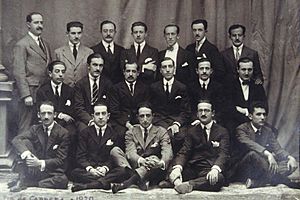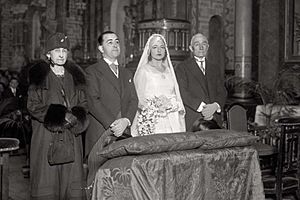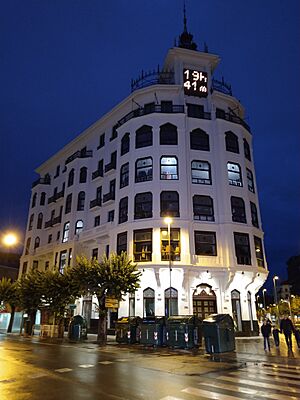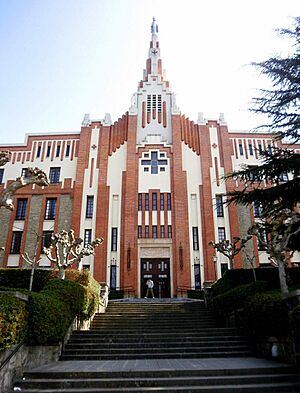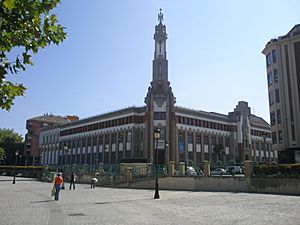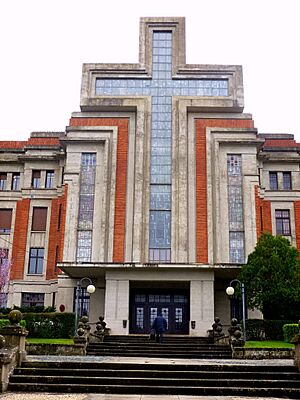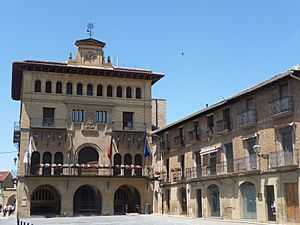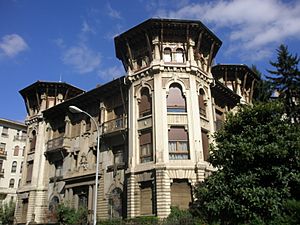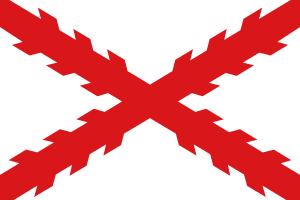Víctor Eusa Razquin facts for kids
Quick facts for kids
Víctor Eusa Razquin
|
|
|---|---|
 |
|
| Born |
Víctor Eusa Razquin
1894 Pamplona, Spain
|
| Died | 1990 (aged 95–96) Pamplona, Spain
|
| Nationality | Spanish |
| Occupation | architect |
| Known for | architect |
| Political party | Carlism |
Víctor Eusa Razquin (1894–1990) was a famous Spanish architect. He mostly worked in Navarre, a region in Spain. Eusa left his unique mark on Pamplona, the capital of Navarre. Many important and impressive buildings there were designed by him.
Eusa is best known for his art déco style. But he also used many other styles. These included eclectic, regionalist, rationalist, expressionist, and neo-classical styles. His most famous buildings are the San Miguel seminary and the Piarist college, both in Pamplona. In the mid-1930s, he was involved in politics. He was part of the Carlist group during the Spanish Civil War.
Contents
Eusa's Early Life and Family
Víctor Eusa's family came from a village called Alzuza in Navarre. This village is near Pamplona, at the foot of the Pyrenees mountains. His grandfather moved to Pamplona in the mid-1800s. Víctor's father, Salustiano Eusa Goñi, was born in Pamplona in 1852. In 1889, he married Tomasa Razquin Ijurco.
Salustiano Eusa Goñi managed properties for wealthy landowners. Over time, he became very rich himself. He was known as a "wealthy owner" and was one of the top taxpayers in Pamplona.
Víctor was the only boy in his family. He had two sisters, one older and one younger. They grew up in a typical middle-class family in Pamplona. They were conservative, believed in traditional values, and were very Catholic. Víctor first went to the Piarist school. Later, he attended Instituto General y Técnico de Pamplona.
From a young age, Víctor was good at drawing. As a teenager, he became interested in design and architecture. Around 1911, Víctor moved to Madrid. He studied at Universidad Central before starting his architecture degree. In 1914, he was accepted into the Escuela Superior de Arquitectura. His main teacher there was Teodoro de Anasagasti. Eusa finished his studies in 1920. He then returned to Navarre to find his first design jobs.
In 1929, Víctor Eusa married Florencia Eugui Garro from Pamplona. She came from another local middle-class family. Her father owned a sugar mill and later an alcohol and vinegar business. He also served as a councilor in the Pamplona town hall.
Víctor and Florencia had a long and happy marriage. Florencia was clever and resourceful. This allowed Víctor to focus on his architecture work. They lived in the Eusa family house in the center of Pamplona. They had four children: Carmen, María Jesús, Isabel, and Miguel Angel.
Víctor Eusa's Architectural Projects
Víctor Eusa worked as an architect from 1920 to 1973. During this time, he worked on about 560 projects. He completed 80 to 120 projects every ten years. His busiest period was from the mid-1920s to the early 1950s. Most of his designs were built. They ranged from huge buildings to small family mausoleums.
He worked as an independent architect for most projects. But he also worked for the government for a while. From 1937 to 1941, he was the temporary city architect of Pamplona. From 1945 to 1962, he was the official provincial architect for Navarre.
About 320 of his projects are in Pamplona. Many are in the area known as Segundo Ensanche. He is so connected to the city that some people call him "the Gaudí of Pamplona." Most of his other buildings are in Navarre. He did very few projects outside his home region.
Many different groups hired Eusa. About 40 projects were for the Navarre government. Around 15 were for the Pamplona town hall. Other town halls hired him for about 30 projects. Religious groups hired him for about 30 projects. His biggest private client was Caja de Ahorros de Navarra, a bank, which hired him for about 60 projects. He also worked for many other businesses and private people.
Historians group Eusa's works into 13 types.
- About 65 projects were for apartment buildings. Some were part of whole housing areas.
- Around 60 designs were for single-family homes. These included small city houses, fancy villas, and large country estates.
- About 25 projects were for public schools and nurseries.
- Around 20 works were for schools run by religious groups.
- About 35 projects were for religious buildings. These included chapels, churches, and monasteries.
- There are about 55 projects for graves, especially family mausoleums.
- About 20 projects were for health services. These included clinics and hospitals.
- Around 30 projects were for hotels, casinos, cinemas, and sports clubs.
- About 15 projects were for government buildings, like town halls.
- Around 75 projects were for banks and financial companies.
- About 20 commercial projects included bars, shops, and garages.
- He also designed parks, gardens, bus stations, and monuments.
Important Buildings by Víctor Eusa
One of Eusa's first big projects was the main office for the insurance company La Vasco Navarra (1924). In the same year, he designed the Hijas de María Immaculada monastery. The Puente de San Jorge in Alcoy (1926) was the only bridge he ever designed.
The Casa de Misericordia (1927) was a huge building with many parts. It even had a large chapel inside. He also designed a clever residential villa for the Eguinoa brothers (1928). Eusa returned to religious themes with the church of Padres Paúles, also known as La Milagrosa (1928).
The Colegio de los PP. Escolapios (1928) was a massive, three-story building with many wings. It was one of his most ambitious and famous works. The Basilica of Nuestra Señora del Puy in Estella (1929) showed his skill with shapes. His apartment buildings at Plaza Príncipe de Viana (1930) showed his talent for city planning. The 7-story building for Casino Eslava (1931) was his last major work before the Spanish Republic began.
The first project of the Republican era was perhaps Eusa's most important work: Seminario Conciliar de San Miguel (1931). It was planned to be very large, covering 98,000 square meters. It had many wings and courtyards. It was designed to be a landmark in Pamplona. A giant cross on its front showed its religious purpose. This was important because a new law at the time limited religious symbols in public.
Other projects followed, like apartment buildings on calle García Castañón and a tennis club (1933). Eusa then designed schools in Zudaire and Fuenterrabia (1933). He also designed the San Manuel crèche in Tafalla with a church next to it (1933). He created a group of twelve 5-story buildings with 400 flats (1933). This was his most notable work in large-scale urban design. His last project before the Spanish Civil War was the Clinic of San Juan de Dios (1935), another large and complex building.
After the war, Eusa worked on urban planning projects. These included Parque de Media Luna (1937), Plaza de la Cruz, a war cemetery, and the Taconera gardens (1938). Religious projects like Convento de las Esclavas and Colegio de Sagrado Corazón (1939) were smaller. In 1940-1941, Eusa worked with José Yárnoz to design Monumento a los Caidos. This was a huge monument meant to be a landmark in Pamplona.
Later important works included Casa Consistorial in Olite (1945), the Coliseo theatre in Eibar (1949), and the headquarters of the insurance company Aurora (1949). This was a 10-story corner building. Eusa's last major work was Colegio Santa María la Real (1951), built for the Marianists. He continued to work on smaller projects like apartment buildings and renovations. Some of his grand designs, like the Ego Sum Veritas church, were never built.
Eusa's Architectural Styles and Techniques
When Eusa was learning, he was influenced by famous architects like Durand, Guadet, and Wagner. He also learned from his teacher, Anasagasti. Later, he adopted styles like the Vienna secession, Paris art deco, and the Dutch Amsterdam school.
His early designs are called eclectic or historicist. The interior of Casino Gran Kursaal in Donostia is a good example. Later, he briefly used a regionalist style. Examples include schools in Zudaire and Fuenterrabia (1933). Some people call these works "romantic."
In the mid-1920s, Eusa was influenced by the Vienna secession style. This can be seen in the Immaculada convent and Casa de Misericordia. The Alcoy bridge is also placed in this period. Other experts say the Alcoy bridge shows "French rationalism," like the Paulist college and church.
In the late 1920s and early 1930s, Eusa developed his unique art déco style. It is sometimes called "déco expressionism." His best works in this style include the Paules convent, the Escolapios college, the El Puy basilica, the Eslava casino, and especially the San Miguel seminary.
After this, in the late 1930s, Eusa moved towards a "rationalist" style. This can be seen in his practical apartment buildings in Pamplona and the San Juan clinic. In the 1940s, he focused on urbanism. This included parks, gardens, cemeteries, and monuments. During this time, Eusa also used a classical style. The Monumento a los Caidos is a strong example of this. Later works from the late 1950s onwards became more functional and had fewer strong stylistic features.
Other styles sometimes mentioned for his architecture include symbolism, medieval historicism, Dutch neoplasticism, beaux arts, and the neomudejár style.
Eusa was a master of reinforced concrete. He was one of the first Spanish architects to understand how flexible and useful it was. The huge cross on the San Miguel facade showed his skill with concrete. He also liked using bricks, especially with concrete. This combination was influenced by Dutch architectural modernism. Steel was mostly used for decoration.
For interior design, Eusa was good at using electric lighting. He used it in many clever ways. This made his buildings not only work better but also look amazing at night. For example, the Casino Eslava was a landmark in Pamplona at night. The courtyards of Casa de Misericordia and the cross of San Miguel were also lit up. The San Miguel cross was originally visible for many kilometers outside the city.
Víctor Eusa's Involvement in Politics
Víctor Eusa grew up in a conservative, Catholic family. He was not very active in politics until he was older. However, in the local elections of April 1931, he joined a local group called "anti-revolutionary candidates." This group included Traditionalists and some independent candidates. Eusa was one of the independents.
The group won many votes, and Eusa was elected to the town hall. But some people claimed there were problems with the election. The new republican government decided to hold the Pamplona election again. Eusa was not on the new list of candidates.
While working on Casa de Misericordia, Eusa often met Blas Inza Cabasés. Blas Inza was a Carlist activist. Historians think this is how Eusa became interested in Carlism. A key moment was when his friend, Ezequiel Lorca, was killed in 1934. He was killed by a socialist. After this, Eusa became more involved in politics. He joined the Carlist group in Pamplona. He even let them use rooms in some buildings.
In the spring of 1936, Eusa said he represented the Carlists in talks with general Mola. However, documents do not fully confirm this. He might have also let the plotters use some of his personal belongings, like his car. When the coup began, the Carlists in Navarre formed a wartime executive group. Eusa became the representative for Pamplona in this group. He also joined two other Carlist sub-groups. In September, he officially joined the requeté (Carlist militia) as a technical leader.
Not much is known about Eusa's work with the Carlists in late 1936 and early 1937. His architectural work almost completely stopped. One exception was a giant altar he designed in late 1936. It was planned to be built in Madrid's Puerta del Sol plaza. This was because the city was expected to be taken by the Nationalists soon.
In May 1937, the new Pamplona town hall changed its employees. The city architect lost his job. Eusa was appointed as the temporary municipal architect. After this, there is no more information about Eusa's direct involvement in Carlist groups. However, his Carlist connections did help his career later on.
See also
 In Spanish: Víctor Eusa para niños
In Spanish: Víctor Eusa para niños


